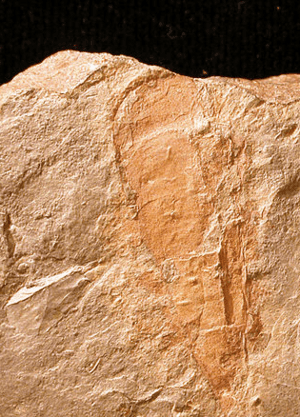Spence Shale facts for kids
Quick facts for kids Spence ShaleStratigraphic range: Cambrian, Miaolingian, Wuliuan ~507.5-506Ma |
|
|---|---|

Hyolithe, Spence Shale
|
|
| Type | Member |
| Thickness | 9–120 m (30–394 ft) |
| Lithology | |
| Primary | carbonate mudstones |
| Other | carbonate-rich siliciclastic mudstones and Wackestones |
| Location | |
| Region | Idaho, Utah |
| Country | United States |
| Type section | |
| Named for | Spence Gulch |
| Named by | Charles Doolittle Walcott |
The Spence Shale is a special layer of rock found in southeastern Idaho and northeastern Utah, in the United States. It's like a middle section of a larger rock group called the Langston Formation. You can see these rocks in places like the Bear River Range and the Wasatch Range.
What makes the Spence Shale so cool? It's famous for its amazing fossils! Many of these fossils are from the Cambrian Period, which was about 500 million years ago. Scientists have found lots of trilobites here. Even more exciting, it has special fossils that are preserved like those found in the famous Burgess Shale in Canada. This means even soft-bodied creatures, which usually don't fossilize, can be found here!
The Spence Shale gets its name from Spence Gulch in Idaho, near a town called Liberty. A scientist named Charles Doolittle Walcott first described this rock layer in 1908.
What is the Spence Shale?
The Spence Shale is a type of rock called a shale. Shale is a fine-grained sedimentary rock. It is made from mud that settled at the bottom of ancient oceans. Over millions of years, this mud was squished and hardened into rock.
The Spence Shale is mostly made of carbonate mudstones. These rocks formed in a shallow sea environment. The thickness of the Spence Shale can vary a lot, from about 9 to 120 meters (30 to 390 feet) thick.
Ancient Life: Spence Shale Fossils
The Spence Shale is a treasure chest for fossil hunters. It's known for preserving many different kinds of ancient animals. These fossils give us clues about what life was like in the oceans over 500 million years ago. Many of the creatures found here are similar to those from the famous Burgess Shale in Canada. This type of preservation is very rare and important.
Arthropods: Ancient Bugs
Arthropods are a group of animals with jointed legs and hard outer shells. This group includes insects, spiders, and crabs today. In the Spence Shale, many different kinds of ancient arthropods have been found.
Soft-bodied Arthropods
Some arthropods from the Spence Shale had soft bodies. These are very rare to find as fossils!
- Anomalocaris: A large, swimming predator.
- Canadaspis: A small, shrimp-like creature.
- Hurdia: Another large predator, related to Anomalocaris.
- Isoxys: A small, bivalved arthropod.
- Leanchoilia: A small arthropod with long, whip-like feelers.
- Sidneyia: A large, bottom-dwelling arthropod.
- Tuzoia: A large, spiny, bivalved arthropod.
- Waptia: A small, shrimp-like creature.
- Yohoia: A small arthropod with claw-like appendages.
Agnostids
Agnostids were tiny, blind arthropods. They looked a bit like small, simple trilobites.
- Pentagnostus
- Ptychagnostus
Trilobites
Trilobites are the most common fossils found in the Spence Shale. They were ancient marine arthropods that lived on the seafloor. They had a hard, segmented shell.
- Alokistocare
- Amecephalus
- Bathyuriscus
- Glossopleura
- Kootenia
- Olenoides
- Zacanthoides
Brachiopods: Shellfish Relatives
Brachiopods are marine animals with two shells, similar to clams. However, they are not closely related to modern clams. They filter food from the water.
- Acrothele
- Lingulella
- Micromitra
Molluscs: Snails and More
Molluscs are a diverse group that includes snails, slugs, and octopuses today. In the Spence Shale, we find early forms of molluscs.
- Latouchella
- Scenella
- Wiwaxia: A slug-like creature covered in scales and spines.
Echinoderms: Spiny-Skinned Creatures
Echinoderms are marine animals with spiny skin. This group includes starfish and sea urchins today.
- Ctenocystis
- Gogia
Worms and Other Creatures
The Spence Shale also holds fossils of various types of worms and other strange creatures that don't fit neatly into other groups.
- Ottoia: A type of worm called a priapulid worm.
- Selkirkia: Another priapulid worm that lived in a tube.
- Acinocricus: A type of lobopodian, an early worm-like animal with stubby legs.
Sponges
Sponges are simple, filter-feeding animals that attach to the seafloor.
- Protospongia
- Vauxia
Mysterious Fossils
Some fossils found in the Spence Shale are so unusual that scientists are still trying to figure out what kind of animals they were. These are called "problematica."
- Banffia
- Eldonia
- Siphusauctum
Ancient Plants and Traces
Besides animals, the Spence Shale also contains fossils of ancient algae and cyanobacteria. These were simple plant-like organisms that lived in the ancient seas.
Scientists also find Trace Fossils in the Spence Shale. These are not the actual bodies of creatures, but signs of their activity. They include things like:
- Cruziana: Marks left by trilobites crawling on the seafloor.
- Rusophycus: Resting traces left by trilobites.
- Planolites: Simple burrows made by worms.
- Coprolite: Fossilized poop! These tell us about the diet of ancient animals.
Images for kids


